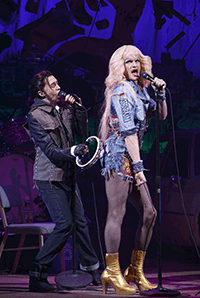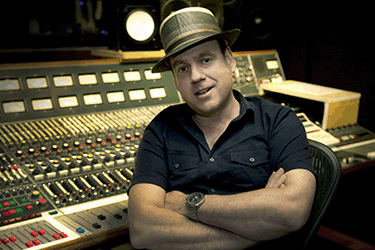Tim O’Heir couldn’t have asked for a better start to his theater career. The veteran producer/engineer earned a Tony nomination for his sound design on the acclaimed revival of Hedwig and The Angry Inch despite having never worked on Broadway before.
Sound designer Tim O’Heir photographed at Mission Sound where the cast recording of Hedwig and The Angry Inch was conducted. Photo by Laura Hanifin, 2014.
It’s a remarkable achievement, but then O’Heir was made for the gig. An off Broadway hit and then a cult classic film before coming to Broadway this year, Hedwig tells its story—about a transgendered singer who suffered a botched sex change operation—entirely through rock songs. And while O’Heir is a Broadway rookie, he has serious rock bona fides. He began his career at Boston’s legendary Fort Apache Studio recording bands like Sebadoh, Come, and Superdrag before moving on to bigger-budget projects like the platinum-selling debut from All-American Rejects, and more recently film scores and soundtracks.
O’Heir’s involvement with Hedwig actually dates to 1999, when the show’s composer, Stephen Trask, hired him to engineer the film soundtrack. O’Heir and Trask would continue to work together on film projects, and when a long-discussed Hedwig revival finally became a reality, Trask again called on O’Heir. Although “there were conversations” among the show’s financial backers about O’Heir’s lack of theater experience, a non-Broadway perspective was exactly what Trask required.
“Stephen wanted me in,” O’Heir says, because the composer wanted “to get away from the Broadway sound.”
Translating rock to the stage
The songs themselves do some of the heavy lifting, with musical director Justin Craig’s arrangements drawing on influences like ‘70s and ‘80s glam and punk rock. Still, with Hedwig’s backing band, The Angry Inch, on stage throughout and performing every note live, it was essential to Trask and O’Heir that the audience experience the sound as they would at a rock show, without a slick Broadway polish.
At the same time, O’Heir says, “we didn’t want to scare anyone away.” That meant applying a level of control you’d never find at a club. The result is akin to a live-in-the-studio recording: a performance with the raw energy of a rock show but the precision engineering “that you need on Broadway.”
Achieving the sound required O’Heir to bridge the aural gaps between rock and Broadway. For example, he says, “on Broadway, the EQ is like a smiley face. They pull all those mids out, so it sounds pleasant. But Hedwig needed to sound like a rock show—we needed it to rip, so we needed those mids in there.”
The vocal mix presented another challenge. In O’Heir’s world, guitars eat up sonic space, and “the vocals sit right in the mix the whole time.” Lyrics are frequently indecipherable, and that’s okay.
“In a rock mix, it’s not so much about the intelligibility of the lyric as it is about the delivery and the emotion,” he says. Not so on Broadway. Because the lyrics have a narrative function, intelligibility is paramount. Broadway mixes treat the music as a bed with the vocals riding on top—not very rock ‘n’ roll.
“I had to get the vocal sitting right there in the mix,” O’Heir says, “not way above the music, which it is in most Broadway shows, but still have the articulation and the intelligibility.”
Set design made the task simple. Because Hedwig is staged like a rock show, the vocals are mostly sung through wired, handheld mics. (O’Heir used relatively affordable Sennheiser 903s, because of the physical nature of the performance.) Needing only a few vocal effects, O’Heir had a clean signal running right to the desk.
“Less is more here,” he says. “Everything is very direct. We’re not using omni lavs and that takes a lot of the room sound out of the way so that we have a direct line to the mic pres.”
Clever stagecraft
Getting the right guitar sound, on the other hand, required clever stagecraft. In keeping with the rock show set design, the guitar players use onstage amps—two Vox AC30s and one Vox Blackstar. Getting the right tones meant cranking the amps to full volume. To avoid blowing the doors off the theater, O’Heir’s team removed the speakers from the amp cabinets and placed them in custom-built isolation boxes, then mic’d them. This allowed O’Heir to harness the full power of the amps with studio-level control.

Lena Hall as Yitzhak and Neil Patrick Harris as Hedwig in Hedwig and The Angry Inch. Photo by Joan Marcus, 2014.
“[The amps] are being mic’d like you would in the studio. I’m using Neumann KM184s and Royer 122s—proper, professional studio mics.”
Meanwhile, the cabs themselves were retrofitted with monitor speakers playing back the mixed guitar tones, so the audience hears only treated sound coming from the amps onstage.
Though he was never short on confidence, O’Heir knew enough to build a team of more-experienced Broadway hands. Established sound designer Kai Harada, house mixer Bob Etter, and production sound engineer Phil Lojo boast decades of cumulative experience and resumes that include hits like The Lion King, Wicked, and Rock of Ages.
Learning curve
While he’s quick to sing their praises, O’Heir admits it wasn’t always easy to convince seasoned Broadway vets to do things his way. For one thing, O’Heir favors an active, hands-on approach to mixing that isn’t common on Broadway. Adding to the difficulty, O’Heir had, on the advice of a friend, opted to use Midas Pro series consoles for the FOH and monitor mix, rather than the Avid and DiGiCo set-ups popular on Broadway. O’Heir chose Midas for their mic pre amps, digital models of classic analog pres. But the gear was unfamiliar to his crew, and, he acknowledges, the desks “aren’t built for these kinds of shows.” All in all, “the learning curve was steep.” But O’Heir contends you can’t argue with results.
“The most important thing was the sound of the board, not the ergonomics. And it sounds fantastic.”
O’Heir also insisted on an unmitigated drum sound. That meant absolutely no gates in the mix, a stance met with disbelief by his new colleagues.
“I wanted the drums to be fresh and live, warts and all. And this is something where I was looked at like I had three heads.”
As it happened, the circa-1907 Belasco Theater’s pre-amplification acoustics carried the drum sound so well, O’Heir had to cut the drums from the speakers feeding the balcony. In fact, the 123-speaker array, threatened to overwhelm the space once the band began rehearsing there in earnest.
“For the first week or so I was constantly running around—upstairs and downstairs, mezzanine, balcony and orchestra—to make sure the balance was happening,” O’Heir says. But thanks to Harada’s expert work on the initial design, making the necessary adjustments was easy.
Ultimately, O’Heir and crew delivered the sound he and Trask had sought from the beginning.
“And as far as I’m concerned,” O’Heir says, “we didn’t compromise one bit. It’s exactly what we wanted.”
Dave Zuckerman is a Brooklyn-based writer and regular contributor to AV Technology Magazine.
